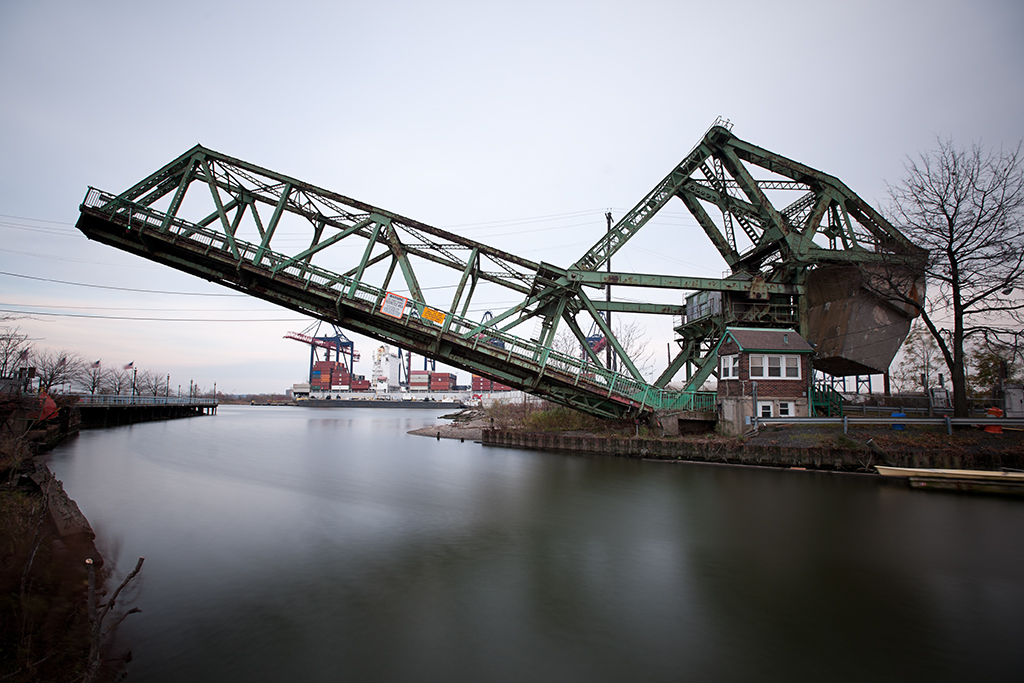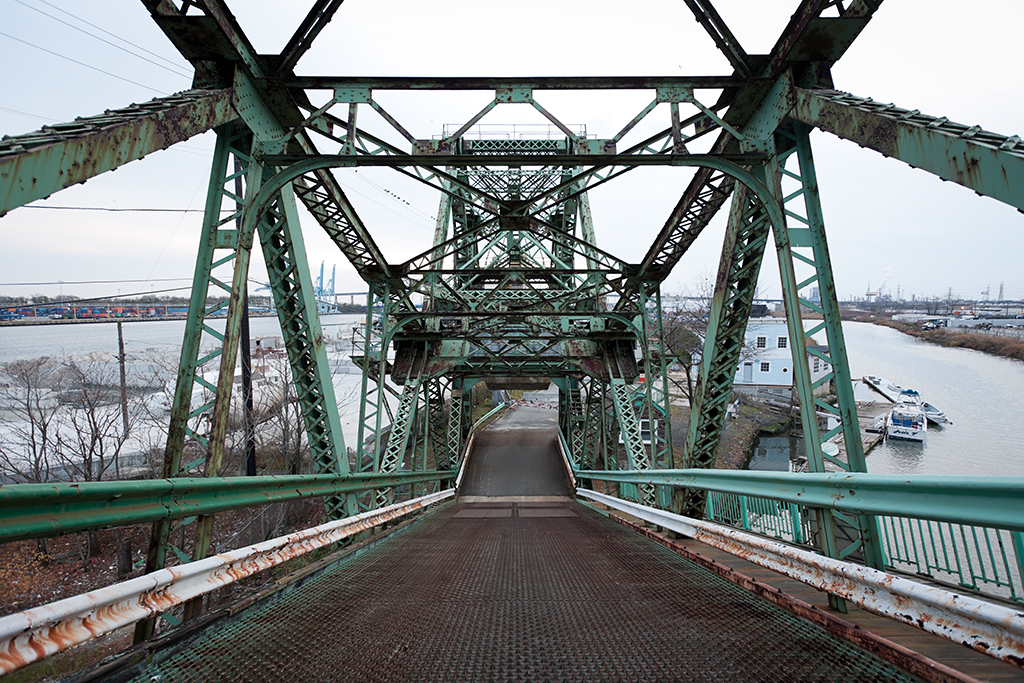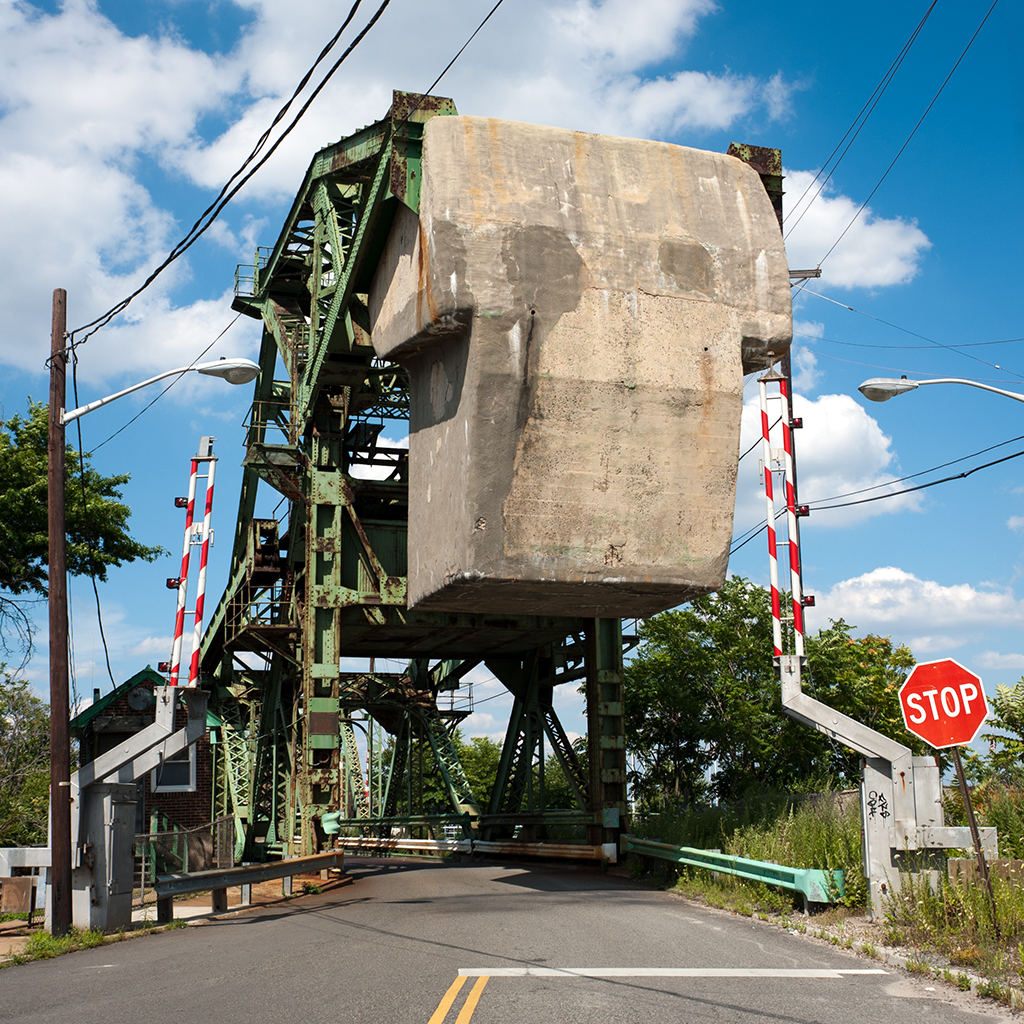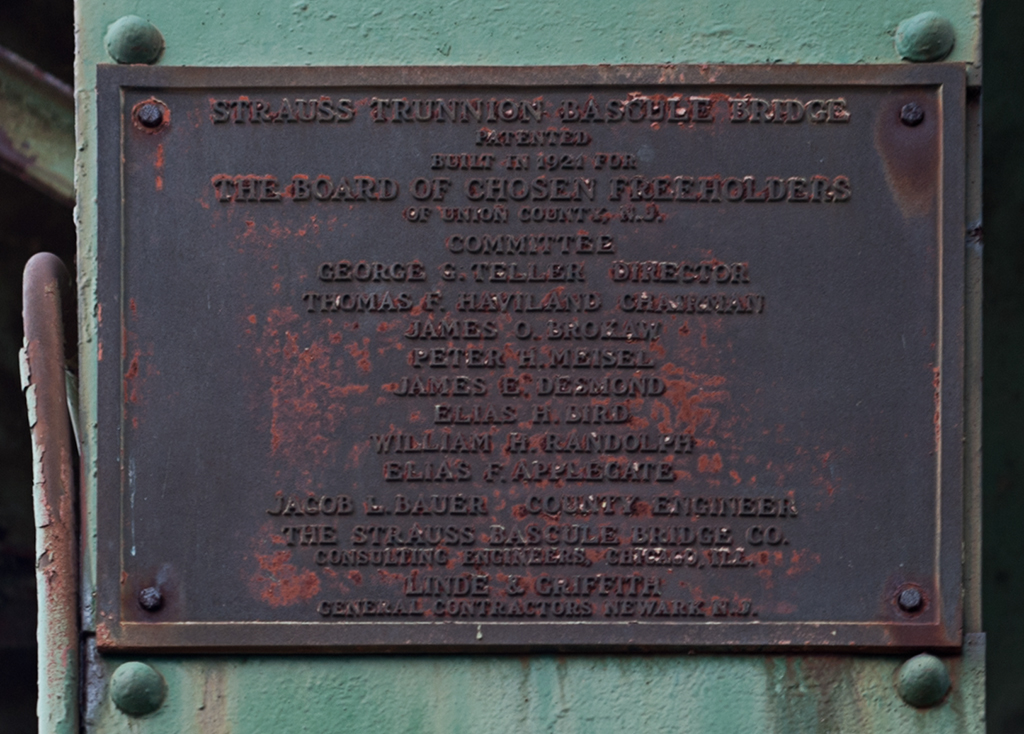
Crosses: Elizabeth River
Location: Carries South Front Street over the Elizabeth River near its outlet into the Arthur Kill, Elizabeth, NJ [satellite map]
Carries: 1 vehicular lane, 1 pedestrian sidewalk
Design: Strauss heel trunnion bascule bridge
Date opened: 1922
The South Front Street Bridge is located just before the Elizabeth River opens up into the Arthur Kill, along the waterfront in Elizabeth, NJ.
Plans for a movable bridge at South Front Street were approved on July 3, 1916 by the Secretary of War. A riparian grant (a deed granted for normally state-owned tidelands) was obtained for $260 from the state of New Jersey in 1917, officially allowing the bridge to be constructed by the City of Elizabeth. The American Bridge Company built the bridge, beginning in 1920; it opened to traffic in 1922.
Design
The South Front Street Bridge is a Strauss trunnion bascule bridge; it was designed by the Strauss Bascule Bridge Company, headed by Joseph Strauss in Chicago. Strauss patented the Strauss bascule design of the trunnion type, which open on a fixed axle. The South Front Street Bridge is a heel trunnion, which is a variation on the design, and is the only remaining road-carrying bridge of its type in New Jersey (though there are still several heel trunnion railroad bridges in the state). The heel truss has the advantage of taking up less space than traditional bascule designs, thus requiring less construction material.
The bridge is skewed, so its trusses are of different lengths: 131’ 8” on the west side and 116’5” on the east. The bridge’s substructure and massive counterweight are made of concrete, which has undergone repairs several times. A small brick bridge house is located adjacent to the bridge; inside are the controls. The machinery which operates the bridge is on the bridge above the road; it consists of original gears and electric motors which were added in 1940.
The bridge was originally built with a wooden roadway, but it was replaced with a steel deck in 1956. The pedestrian walkway is still constructed of wood, though not the original wood deck. The bridge underwent significant repairs in 1976.

The Elizabeth River’s Decline
The Elizabeth River was once home to six movable bridges, to accommodate its heavy use by ocean-going vessels. However, shipping on the river came to an end soon after the the 1951 opening of the New Jersey Turnpike. The U.S. Corps of Engineers deemed that three of the movable bridges would become fixed later in the 1950s. Another of the six (the Baltic Street Bridge) had been left isolated by the Turnpike construction, and it was sold for scrap in 1954. The South First Street Bridge, built in 1908, suffered a fire in the bridge tender’s house in 1984. With its control center gone, it permanently remained closed. The bridge was replaced completely in 2010. This leaves the South Front Street bridge as the only remaining operational drawbridge in all of Union County.
Only a few hundred feet of the Elizabeth River are still navigable, so the waterway only sees vessels designed for recreation, not industry. Still, a 2003 publication about Elizabeth estimated that the bridge was opened an average of 2,000 times a year [1].
Contamination Next Door
The bridge sits adjacent to the former site of the Chemical Control Corporation, a notorious part of New Jersey’s history with chemical dumping. The property, bordering on the southeastern end of the bridge, was originally marshland, but was filled in when Elizabeth developed much of its land for industrial use during the latter half of the 19th century. The Chemical Control Corporation was in operation from 1970 to 1978 as a disposal facility for hazardous waste. The company, which began as a legitimate business, became more notable for its practice of disposing of waste illegally, and was cited repeatedly until the state forced it to close in March of 1979.

The New Jersey Department of Environmental Protection began cleanup at the site shortly after; about 400,000 gallons of bulk solids and liquids, infectious and radioactive waste, and explosive liquids were removed. In May, upon hearing that the cleanup had uncovered nitroglycerin and other potential explosives, Elizabeth’s mayor Thomas G. Dunn declared a state of emergency in the area a half mile around the site, restricting pedestrian and vehicular traffic. The cleanup and restrictions were fortunate, because on April 21, 1980 there was an explosion at Chemical Control which led to a fire of spectacular proportions: drums of waste were launched into the air and exploded over the Arthur Kill; it took 10 hours to get the blaze under control but firefighters spent weeks at the site. NJDEP continued its cleanup and investigations after the fire; unfortunately, many of the records of which companies were connected to which hazardous materials were stored on-site and therefore lost.
In October 1981, it was proposed that the Chemical Control site be included on the National Priorities List of Superfund sites; its inclusion was finalized in September 1983. Cleanup continued, and a 1985-6 study found that contaminants including PCBs, naphalene, and benzene were still present in the soil, groundwater, and surface water. A slurry wall was later constructed around the site and anchored into a layer of clay under it; this helped stop groundwater contamination. A 2003 study of the site found that in general the contaminants which were contained during the cleanup remain contained, though it was noted that small area around the site may still be somewhat contaminated (one of three sampling stations still showed high levels of vinyl chloride and 2-butanone [2]).

The Bridge’s Future
In 2008, it was announced that the New Jersey Department of Transportation would supply $330,000 to repair the bridge. Work was done to reinforce the deck. The city was granted a further $1,000,000 in 2010 for more rehabilitation work. However, due to ongoing structural concerns, the bridge has been left in the open position since March 4, 2011; traffic is rerouted to the new South First Street Bridge. A study is underway to determine whether the bridge can be rehabilitated or not. The bridge remains eligible for the State and National Registers of Historic Places.
– – – – – –
References
1921. Hague, Joseph T. Parks and other public properties of the City of Elizabeth New Jersey. Elizabeth: The City of Elizabeth. Retrieved from: books.google.com
1925. Waddell, J.A.L. Bridge Engineering, Volume 1, p. 702-706. New York: John Wiley & Sons. Retrieved from: openlibrary.org
1943. Hool and Kinne. Movable and Long-Span Steel Bridges. New York: McGraw Hill.
1979, May 5. Narvaez, Alfonso A. Mayor declares emergency near New Jersey chemical plant. New York Times, p. 26.
2002. New Jersey (State). New Jersey historic bridge data, Union County, p. 30. Trenton: New Jersey Dept. of Transportation, Bureau of Environmental Services. Retrieved from: state.nj.us
[1] 2003. Turner, Jean-Rae and Richard T. Koles. Elizabeth: The first capital of New Jersey, p. 126. Charleston, SC: Arcadia. Retrieved from: books.google.com
[2] 2004, January. Second five-year report for Chemical Control Corporation Superfund site, City of Elizabeth, Union County, New Jersey. New York, NY: United States Environmental Protection Agency. Retrieved from: epa.gov
2008, March 28. Union County to repair historic South Front Street Bridge in Elizabeth. County of Union, New Jersey. Retrieved from: ucnj.org
2011. Belton, Thomas J. Protecting New Jersey’s environment: From Cancer Alley to the New Garden State. New Brunswick, NJ: Rivergate Books.
Fantastic write up. I work near this bridge,everyday. I always wondered the history of it and why it remains in the up position.
Thanks!
John A.